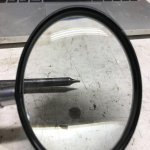Yes. Go to kwk or another site with the pressure ratings. Go to PPU website - they load for both and use both names - much lower pressure limit by SAAMI in their "8mm Mauser" - that is SAAMI name for it - not a name from Europe - because a North American might use it in a .318" bore rifle and would not blow his head off with the SAAMI loading. European CIP differentiates between the bore sizes - 8x57I and 8x57IS. And European ammo makers will load for 8x57IS (sometimes spelled as "JS", instead of "IS"). PPU also loads for North America - 8mm Mauser - same bullet, same brass, about 200 fps less velocity...
go here:
http://kwk.us/pressures.html - SAAMI versus CIP piezo limits for 8x57JS - 35K versus 57K in PSI; 37K versus 49K using crusher - so that would be CUP units.
EDIT 7-Jun-2021 - was able to get to PPU website - 8mm Mauser - 200 grain Match - bullet used is B-451 - 665 m/s; 8x57IS - 200 grain Match - bullet used is B-451 (same bullet) - 740 m/s. So, 75 m/s difference. That is pretty much 250 ft/s difference. Will find similar with the regular soft point hunting loads. 8mm Mauser versus 8x57IS PPU factory loads.
Basically, if you go to a store in Canada and bought a box of PPU 8x57JS, and a box of PPU 8mm Mauser, you bought two different loading that will both fit and work in your WWII 7.92 marked Mauser rifle - significant difference in "power" though, even with identical bullet weights. Most likely the source of the stories about how "wimpy" the 8mm Mauser was, compared to 30-06, because SAAMI limited it to be like that. Now load up 8x57JS and do the comparison... Mix up likely most often occurred when gun rag writers (especially American) wrote as if "8mm Mauser" was interchangeable name for "8x57" and never bothered with the letters that differentiate between the bore sizes, and who's only experience was with SAAMI compliant American loaded ammo.
I do not know if they exist, but a North American made rifle, with barrel stamp as "8mm Mauser", is using the SAAMI designation, and should meet SAAMI requirements - would not think it is "rated" for the European 8x57JS loads, but I do not know that...
If someone screwed a barrel onto a receiver and stamped it as "8x57" - not sure what that is - is neither a SAAMI, nor a CIP, name for any cartridge.












































































